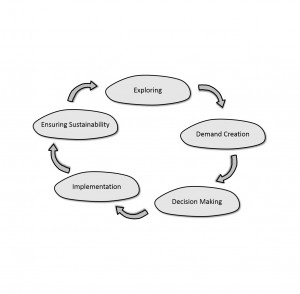المقدمة
عادة ما يتم تخطيط وتنفيذ تدخلات المياه والصرف الصحي والنظافة الصحية في مخيمات النازحين طويلة الأمد خلال "مرحلة عناية صيانة" المخيمات ، حيث ينصب التركيز على تدخلات المياه والصرف الصحي والنظافة الصحية على تطوير وتوسيع المرافق القائمة التي تنفذ خلال مرحلة الطوارئ لضمان البقاء الأساسي. وكلما تحسنت الاستدامة على المدى الطويل في خطط الاستجابة الفورية، كلما كان من السهل على الجهات الفاعلة الإنسانية في المخيمات طويلة الأمد أن تعمل على صيانة وترقية الخدمات باستمرار. ولهذا السبب، ووفقًا لمفهوم الربط بين الإغاثة والتأهيل والتنمية، يجب دائمًا تيسير المعونة الإنسانية وإعادة التأهيل والتعمير فضلًا عن التعاون الإنمائي عند تخطيط التدخلات الإنسانية.
على نقيض المخيمات، تواجه الجهات الفاعلة في المجال الإنساني في أوضاع المخمات طويلة الأمد ضغطاً أقل في وقت تصميم تدخلات المياه والصرف الصحي والنظافة الصحية. وعلى الجانب السلبي، كثيرًا ما تكون الموارد المالية المتاحة محدودة للغاية بسبب انخفاض الدعم المقدم من المانحين. ولهذا السبب، يجب أن يركز التخطيط لتدخلات المياه والصرف الصحي والنظافة الصحية في أوضاع المخيمات طويلة الأمد على فعالية التكلفة والجودة وديمومة الخدمات.
وتصف المعايير الأساسية لمشروع "سفير" العمليات الضرورية لتحقيق الحد الأدنى من معايير لمشروع أسفير للاستجابة الإنسانية. وفقًا للمعايير الأساسية، يجب أن تضمن الاستجابة الإنسانية 1 (اتباع منهج يركز على حقوق الإنسان ويأخذ في الاعتبار قدرة الناس على تصميم الاستجابة المناسبة، 2 (التنسيق والتعاون بين جميع المنظمات والسلطات لضمان أقصى قدر من الكفاءة والفعالية.
وعند الحاجة إلى تحقيق المعايير الأساسية، ينبغي أن تؤخذ في الحسبان الاحتياجات المحددة المتعلقة بالسياق والمجموعة المستهدفة والقدرات القائمة ومرحلة الأزمة. لذا فإن إجراء تقييم احتياجات مشروع المياه والصرف الصحي والنظافة يعد أمرًا أساسيًا لأجل وضع خطط تدخل كافية بما في ذلك الأهداف العامة والأنشطة المقررة. ويعتمد مستوى التفاصيل على مرحلة تصميم البرنامج. على سبيل المثال، قد يشير تصميم مخطط البرنامج (أو المسودة الأولية) ببساطة إلى أنه يجب توفير المراحيض المشتركة في حين قد يصف التصميم التفصيلي أنواع المراحيض المقترحة (انظر المعيار الأساسي 4 في كتيب أسفير للتصميم والاستجابة).
ومن أجل ضمان استمرار الاستجابة الإنسانية المخططة لتلبية الاحتياجات، ينبغي تكييف التدخلات استنادًا إلى نتائج الرصد والتقييم المستمرين، وكذلك التأثير على السكان المتضررين (كما ورد في المعيار الأساسي 5 لأـسفير).
ويقدم هذه النموذج عددًا من الاستراتيجيات و النُهج والأدوات التشاركية للتخطيط الفعال القائم على الاحتياجات في مخيمات النازحين طويلة الأمد .
A review of water and sanitation provision in refugee camps in association with selected health and nutrition indicators – the need for integrated service provision
International Organization for Migration (IOM), Norwegian Refugee Council (NRC) and UN Refugee Agency (UNHCR)`s Camp Management Toolkit provide tools and approaches to provide concrete guidance on facilitating hygiene improvement in an acute, early stage of an emergency relevant to camps. This toolkit is applicable to both IDPs and refugees living in communal settings.
CRONIN, A. ; SHRESTHA, D. ; CORNIER, N. ; ABDALLA, F. ; EZARD, N. ; ARAMBURU, C. (2008): A review of water and sanitation provision in refugee camps in association with selected health and nutrition indicators – the need for integrated service provision. المُدخلات: Journal of Water and Health: URL [Accessed: 26.10.2016]Water, Sanitation and Hygiene. Meeting the challenge of rapidly increasing humanitarian needs in WASH. DG ECHO Thematic Policy No.2
This thematic policy document provides information on meeting the challenges of rapidly increasing humanitarian needs. It provides information on basic principles of humanitarian response, emergency response and preparedness and response in acute, post-acute, protracted, and chronic crises, key determinants for interactions, guidance on coordination, advocacy, decision trees, and technical guidelines. It provides various insights on operations and maintenance planning for humanitarian crisis needs. The EC humanitarian WASH assistance follows the following objectives: 1) To ensure timely and dignified access to sufficient and safe WASH services for populations threatened by on-going, imminent or future humanitarian crises, and to increase their resilience to withstand water stress and shocks. 2) To implement measures to prevent the spread of WASH related diseases in populations threatened by on-going, imminent or future humanitarian crises. 3) To enhance the impact, relevance, efficiency and effectiveness in the delivery of WASH assistance by strengthening the capacities of the humanitarian aid system, including its coordination mechanism.
EUROPEAN COMMISSION (2014): Water, Sanitation and Hygiene. Meeting the challenge of rapidly increasing humanitarian needs in WASH. DG ECHO Thematic Policy No.2. Brussels: European Commission URL [Accessed: 31.10.2016]Humanitarian Charter and Minimum Standards in Humanitarian Response
The Sphere Project is an initiative to determine and promote standards by which the global community responds to the plight of people affected by desasters. This handbook contains a humanitarian charter, protection principles and core standards in four disciplines: Water, sanitation and hygiene; food security and nutrition; shelter, settlements and non-food items; and health action.
THE SPHERE PROJECT (2011): Humanitarian Charter and Minimum Standards in Humanitarian Response. Bourton on Dunsmore: Practcal Action Publishing URL [Accessed: 31.05.2019]Concept on LRRD Linking Relief, Rehabilitation and Development
This document establishes the frame of reference for the systematic incorporation of the LRRD approach into the Swiss Red Cross (SRC)’s humanitarian aid operations, its re-construction/rehabilitation activities and its development cooperation programmes, and supplements their specific strategic- conceptual foundations. The concept is the outcome of broadly supported SRC internal processes and provides SRC international cooperation staff with guidelines for planning and implementing the LRRD approach in programmes. It also serves as a basis for dialogue within the International Red Cross and Red Crescent Movement and with partner organisations, authorities and other interested institutions.
SWISS RED CROSS (2010): Concept on LRRD Linking Relief, Rehabilitation and Development. Bern: Swiss Red Cross URL [Accessed: 06.02.2017]
